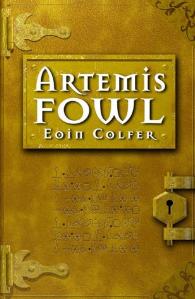 W
WArtemis Fowl is an Irish young adult fantasy novel written by Irish author Eoin Colfer. It is the first book in the Artemis Fowl series, followed by Artemis Fowl: The Arctic Incident. Described by its author as "Die Hard with fairies", it follows the adventures of Artemis Fowl, a twelve-year-old criminal mastermind, as he kidnaps a fairy for a large ransom of gold.
 W
WArtemis Fowl and the Arctic Incident, known in America as Artemis Fowl: The Arctic Incident, is a young adult and fantasy novel written by Irish author Eoin Colfer, published in 2002. It is the second book in the Artemis Fowl series, preceded by Artemis Fowl and followed by Artemis Fowl: The Eternity Code. It follows the adventures of the twelve-year-old criminal mastermind, Artemis Fowl II, as he thwarts a goblin rebellion and rescues his father, Artemis Fowl I. The third-person narration switches back and forth constantly, allowing the reader to understand more of what is going on. A New York Times bestseller, the novel was well received by critics, and reviews compared its quality and success to those of its predecessor.
 W
WAt Swim-Two-Birds is a 1939 novel by Irish writer Brian O'Nolan, writing under the pseudonym Flann O'Brien. It is widely considered to be O'Brien's masterpiece, and one of the most sophisticated examples of metafiction.
 W
WAn Béal Bocht is a 1941 novel in Irish by Brian O'Nolan, published under the pseudonym "Myles na gCopaleen". It is widely regarded as one of the greatest Irish-language novels of the 20th century. An English translation by Patrick C. Power appeared in 1973. Stan Gebler Davies wrote: "The Poor Mouth is wildly funny, but there is at the same time always a sense of black evil. Only O'Brien's genius, of all the writers I can think of, was capable of that mixture of qualities."
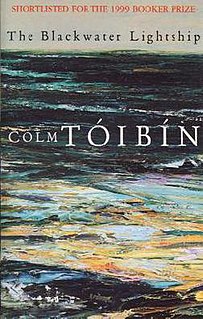 W
WThe Blackwater Lightship is a 1999 novel written by Irish novelist Colm Tóibín, and was short-listed for the Booker Prize.
 W
WThe Blue Lagoon is a romance novel written by Henry De Vere Stacpoole and was first published by T. Fisher Unwin in 1908. It is the first novel of the Blue Lagoon trilogy, which also includes The Garden of God (1923) and The Gates of Morning (1925). The novel has inspired several film adaptations, most notably The Blue Lagoon starring Brooke Shields as Emmeline and Christopher Atkins as Richard, in which they are two fictional English children.
 W
WBorstal Boy is a 1958 autobiographical book by Brendan Behan. The story depicts a young, fervently idealistic Behan, who loses his naïveté over the three years of his sentence to a juvenile borstal, softening his radical Irish republican stance and warming to his British fellow prisoners. From a technical standpoint, the novel is chiefly notable for the art with which it captures the lively dialogue of the Borstal inmates, with all the variety of the British Isles' many subtly distinctive accents intact on the page. Ultimately, Behan demonstrated by his skillful dialogue that working class Irish Catholics and English Protestants actually had more in common with one another through class than they had supposed, and that alleged barriers of religion and ethnicity were merely superficial and imposed by a fearful middle class.
 W
WThe Boy in the Striped Pyjamas is a 2006 Holocaust novel by Irish novelist John Boyne. Much like the process he undertakes when writing most of his novels, Boyne has said that he wrote the entire first draft in two and a half days, without sleeping much, but also that he was quite a serious student of Holocaust-related literature for years before the idea for the novel even came to him. The book has received mixed criticism, with positive reviews praising the novel as a moral tale, while negative reviews attack the book's historical inconsistencies and the potential damage it could cause to people's education about the Holocaust.
 W
WBreakfast on Pluto is a 1998 novel by Patrick McCabe. The book was shortlisted for the 1998 Booker Prize, and was adapted for the screen by McCabe and Neil Jordan; Jordan directed the 2005 film. The author derived the novel's title from the 1969 hit record Breakfast On Pluto by Don Partridge.
 W
WBrooklyn is a 2009 novel by Irish author Colm Tóibín. It won the 2009 Costa Novel Award, was shortlisted for the 2011 International Dublin Literary Award and was longlisted for the 2009 Man Booker Prize. In 2012, The Observer named it as one of "The 10 best historical novels".
 W
WThe Butcher Boy is a 1992 novel by Patrick McCabe. Set in a small town in Ireland in the early 1960s, it tells the story of Francis "Francie" Brady, a schoolboy who retreats into a violent fantasy world as his troubled home life collapses.
 W
WCarmilla is an 1872 Gothic novella by Irish author Joseph Sheridan Le Fanu and one of the early works of vampire fiction, predating Bram Stoker's Dracula (1897) by 26 years. First published as a serial in The Dark Blue (1871–72), the story is narrated by a young woman preyed upon by a female vampire named Carmilla, later revealed to be Mircalla, Countess Karnstein. The character is a prototypical example of the lesbian vampire, expressing romantic desires toward the protagonist. The novella notably never acknowledges homosexuality as an antagonistic trait, leaving it subtle and relatively unmentioned. The story is often anthologized and has been adapted many times in film and other media.
 W
WCatholics is a novel by Northern Irish-Canadian writer Brian Moore. It was first published in 1972, and was republished in 2006 by Loyola Press with an introduction by Robert Ellsberg and a series of study questions.
 W
WCircle of Friends is a 1990 novel by the Irish author Maeve Binchy. Set in Dublin, as well as in the fictitious town of Knockglen in rural Ireland during the 1950s, the story centres on a group of university students. The novel was adapted into a 1995 feature film directed by Pat O'Connor.
 W
WCirque du Freak is the first of twelve novels in The Saga of Darren Shan by Darren Shan, published in January 2000. The story begins with Darren Shan and his best friend Steve "Leopard" Leonard visiting an illegal freak show where an encounter with a vampire and a deadly, unique spider forces them to make life-changing choices that neither of them could have ever thought possible. Throughout the novels Darren is put through sticky situations, trials and tribulations while adjusting to his new life. Darren had no clue what to expect but somehow managed to become an essential character in a world that he just stepped into. As time passes for the young Darren Shan he must learn to live with his new body, appetite, long life span, and world of unknown that he will soon come to discover. The 13 novels are packed with thrilling stories and can appeal to audiences of any age.
 W
WThe Commitments (1987) is a novel by Irish writer Roddy Doyle. The first episode in The Barrytown Trilogy, it is about a group of unemployed young people in the north side of Dublin, Ireland, who start a soul band.
 W
WThe Country Girls is a trilogy by Irish author Edna O'Brien. It consists of three novels: The Country Girls (1960), The Lonely Girl (1962), and Girls in Their Married Bliss (1964). The trilogy was re-released in 1986 in a single volume with a revised ending to Girls in Their Married Bliss and addition of an epilogue. The Country Girls, both the trilogy and the novel, is often credited with breaking silence on sexual matters and social issues during a repressive period in Ireland following World War II and was adapted into a 1983 film. All three novels were banned by the Irish censorship board and faced significant public disdain in Ireland. O'Brien won the Kingsley Amis Award in 1962 for The Country Girls.
 W
WCré na Cille is an Irish language novel by Máirtín Ó Cadhain. It was first published in 1949. It is considered one of the greatest novels written in the Irish language.
 W
WThe Dark Fields is a 2001 techno-thriller novel by Irish writer Alan Glynn. It was re-released in March 2011 under the title Limitless, in order to coincide with its 2011 film adaptation.
 W
WDracula is an 1897 Gothic horror novel by Irish author Bram Stoker. It introduced the character of Count Dracula and established many conventions of subsequent vampire fantasy. The novel tells the story of Dracula's attempt to move from Transylvania to England so that he may find new blood and spread the undead curse, and of the battle between Dracula and a small group of people led by Professor Abraham Van Helsing.
 W
WEsther Waters is a novel by George Moore first published in 1894.
 W
WEureka Street is a novel by Northern Irish author Robert McLiam Wilson, published in 1996 in the UK, it focuses on the lives of two Belfast friends, one Catholic and one Protestant, shortly before and after the IRA ceasefire in 1994. A BBC TV adaptation of Eureka Street was broadcast in 1999.
 W
WEvening Class is a 1996 novel by the Irish author Maeve Binchy. It was adapted as the award-winning film Italian for Beginners (2000) by writer-director Lone Scherfig, who failed to formally acknowledge the source, although at the very end of the closing credits is the line 'with thanks to Maeve Binchy'.
 W
WFelicia's Journey is a novel written by William Trevor, first published in 1994. The novel was made into a 1999 film of the same name.
 W
WThe Gadfly is a novel by Irish writer Ethel Voynich, published in 1897, set in 1840s Italy under the dominance of Austria, a time of tumultuous revolt and uprisings. The story centres on the life of the protagonist, Arthur Burton, as a member of the Youth movement, and his antagonist, Padre Montanelli. A thread of a tragic relationship between Arthur and his love, Gemma, simultaneously runs through the story. It is a story of faith, disillusionment, revolution, romance, and heroism.
 W
WGulliver's Travels, or Travels into Several Remote Nations of the World. In Four Parts. By Lemuel Gulliver, First a Surgeon, and then a Captain of Several Ships is a 1726 prose satire by the Irish writer and clergyman Jonathan Swift, satirising both human nature and the "travellers' tales" literary subgenre. It is Swift's best known full-length work, and a classic of English literature. Swift claimed that he wrote Gulliver's Travels "to vex the world rather than divert it".
 W
WThe Heat of the Day is a novel by Anglo-Irish Elizabeth Bowen, first published in 1948 in the United Kingdom, and in 1949 in the United States of America.
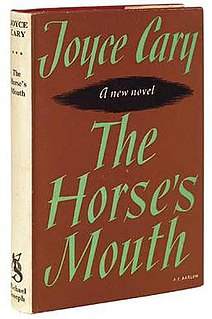 W
WThe Horse's Mouth is a 1944 novel by Anglo-Irish writer Joyce Cary, the third in his First Trilogy, whose first two books are Herself Surprised (1941) and To Be A Pilgrim (1942). The Horse's Mouth follows the adventures of Gulley Jimson, an artist who would exploit his friends and acquaintances to earn money, told from his point of view, just as the other books in the First Trilogy tell events from their central characters' different points of view. Cary's novel also uses Gulley's unique perspective to comment on the social and political events of the time.
 W
WThe House in Paris is Elizabeth Bowen's fifth novel. It is set in France and Great Britain following World War I, and its action takes place on a single February day in a house in Paris. In that house, two young children—Henrietta and Leopold—await the next legs of their respective journeys: Henrietta is passing through on her way to meet her grandmother, while Leopold is waiting to meet his mother for the first time. The first and third sections of the novel, both called "The Present," detail what happens in the house throughout the day. The middle section of the book is an imagined chronicle of part of the life of Leopold's mother, Karen Michaelis, revealing the background to the events that occur in Mme Fisher's home on the day.
 W
WThe Informer is a novel by Irish writer Liam O'Flaherty published in 1925. It received the 1925 James Tait Black Memorial Prize.
 W
WThe Jewel of Seven Stars is a horror novel by Irish writer Bram Stoker, first published by Heinemann in 1903. The story is a first-person narrative of a young man pulled into an archaeologist's plot to revive Queen Tera, an ancient Egyptian mummy. It explores common fin de siècle themes such as imperialism, the rise of the New Woman and feminism, and societal progress.
 W
WJudith Hearne, was regarded by Northern Irish-Canadian writer Brian Moore as his first novel. The book was published in 1955 after Moore had left Ireland and was living in Canada. It was rejected by 10 American publishers, then was accepted by a British publisher. Diana Athill's memoir Stet (2000) has information about the publishing of Judith Hearne.
 W
WThe Lair of the White Worm is a horror novel by the Irish writer Bram Stoker. It was first published by Rider and Son of London in 1911 – the year before Stoker's death – with colour illustrations by Pamela Colman Smith. The story is based on the legend of the Lambton Worm. It has also been issued as The Garden of Evil.
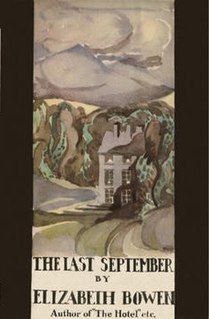 W
WThe Last September is a 1929 novel by the Anglo-Irish writer Elizabeth Bowen, concerning life in Danielstown, Cork during the Irish War of Independence, at a country mansion. John Banville wrote a screenplay based on the novel; the film adaptation was released in 1999.
 W
WThe Life and Opinions of Tristram Shandy, Gentleman, also known as just Tristram Shandy, is a novel by Laurence Sterne. It was published in nine volumes, the first two appearing in 1759, and seven others following over the next seven years. It purports to be a biography of the eponymous character. Its style is marked by digression, double entendre, and graphic devices.
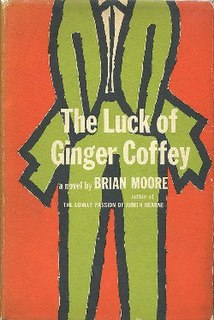 W
WThe Luck of Ginger Coffey, a novel by Northern Irish-Canadian writer Brian Moore, was published in 1960, in the United States by The Atlantic Monthly and in the United Kingdom by Andre Deutsch. In Canada, it received a Governor General's Award. The book was made into a film, directed by Irvin Kershner, and released in 1964. Robert Shaw starred in the title role.
 W
WMoondyne is an 1879 novel by John Boyle O'Reilly. It is loosely based on the life of the Western Australian convict escapee and bushranger Moondyne Joe. It is believed to be the first ever fictional novel set in Western Australia.
 W
WThe Mouse on the Moon is a novel by Irish author Leonard Wibberley. It was released in 1962 as the sequel to The Mouse That Roared. In it, the people of the Duchy of Grand Fenwick, an isolated mountain microstate, attempt space flight using wine as a propellant. It satirizes the space race, Cold War and politics. It was adapted into a film The Mouse on the Moon in 1963.
 W
WThe Mouse That Roared is a 1955 Cold War satirical novel by Irish American writer Leonard Wibberley, which launched a series of satirical books about an imaginary country in Europe called the Duchy of Grand Fenwick. Wibberley went beyond the merely comic, using the premise to make commentaries about modern politics and world situations, including the nuclear arms race, nuclear weapons in general, and the politics of the United States.
 W
WThe Newton Letter is a 1982 novella by John Banville. Drawing comparisons with Ford Madox Ford's The Good Soldier and John Hawkes's The Blood Oranges for their use of the unreliable narrator, The Newton Letter was described in The New York Times as Banville's "most impressive work to date". Colm Tóibín has stated that the book, among others by Banville, ought to have won the Booker Prize
 W
WThe Picture of Dorian Gray is a Gothic and philosophical novel by Oscar Wilde, first published complete in the July 1890 issue of Lippincott's Monthly Magazine. Fearing the story was indecent, prior to publication the magazine's editor deleted roughly five hundred words without Wilde's knowledge. Despite that censorship, The Picture of Dorian Gray offended the moral sensibilities of British book reviewers, some of whom said that Oscar Wilde merited prosecution for violating the laws guarding public morality. In response, Wilde aggressively defended his novel and art in correspondence with the British press, although he personally made excisions of some of the most controversial material when revising and lengthening the story for book publication the following year.
 W
WA Portrait of the Artist as a Young Man is the first novel of Irish writer James Joyce. A Künstlerroman written in a modernist style, it traces the religious and intellectual awakening of young Stephen Dedalus, Joyce's fictional alter ego, whose surname alludes to Daedalus, Greek mythology's consummate craftsman. Stephen questions and rebels against the Catholic and Irish conventions under which he has grown, culminating in his self-exile from Ireland to Europe. The work uses techniques that Joyce developed more fully in Ulysses (1922) and Finnegans Wake (1939).
 W
WPS, I Love You is the debut novel by Irish writer Cecelia Ahern, published in 2004. It claimed the number one best-seller status in Ireland, Britain, the United States, Germany, and the Netherlands, and was on the number one spot in Ireland for nineteen weeks.
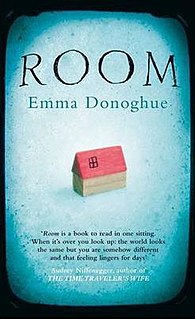 W
WRoom is a 2010 novel by Irish-Canadian author Emma Donoghue. The story is told from the perspective of a five-year-old boy, Jack, who is being held captive in a small room along with his mother. Donoghue conceived the story after hearing about five-year-old Felix in the Fritzl case, and a 2008 court case in which an Austrian woman and her children are held captive for eight years in a small room similar to the one in the novel.
 W
WThe Sea is a 2005 novel by John Banville. His fifteenth book, it won the 2005 Booker Prize.
 W
WThe Secret Scripture is a 2008 novel written by Irish writer Sebastian Barry.
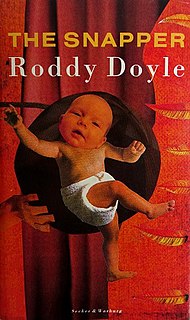 W
WThe Snapper (1990) is a novel by Irish writer Roddy Doyle and the second novel in The Barrytown Trilogy.
 W
WTara Road is a novel by Maeve Binchy. It was chosen as an Oprah's Book Club selection in September 1999.
 W
WThe Temptation of Eileen Hughes, published in 1981, is a novel by Northern Irish-Canadian writer Brian Moore. It portrays a quiet young shop assistant from Northern Ireland and her relationship with her rich employers Bernard and Mona McAuley who take her on a trip to London.
 W
WUlysses is a modernist novel by Irish writer James Joyce. It was first serialized in parts in the American journal The Little Review from March 1918 to December 1920 and then published in its entirety in Paris by Sylvia Beach on 2 February 1922, Joyce's 40th birthday. It is considered one of the most important works of modernist literature and has been called "a demonstration and summation of the entire movement." According to Declan Kiberd, "Before Joyce, no writer of fiction had so foregrounded the process of thinking".
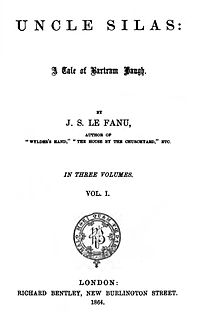 W
WUncle Silas, subtitled "A Tale of Bartram-Haugh", is an 1864 Victorian Gothic mystery-thriller novel by the Irish writer J. Sheridan Le Fanu. Despite Le Fanu resisting its classification as such, the novel has also been hailed as a work of sensation fiction by contemporary reviewers and modern critics alike. It is an early example of the locked-room mystery subgenre, rather than a novel of the supernatural, but does show a strong interest in the occult and in the ideas of Emanuel Swedenborg, a Swedish scientist, philosopher and Christian mystic.
 W
WThe Van is a 1991 novel by Roddy Doyle and the third novel in The Barrytown Trilogy. It was shortlisted for the Booker Prize (1991).
 W
WThe Vicar of Wakefield – subtitled A Tale, Supposed to be written by Himself – is a novel by Irish writer Oliver Goldsmith (1728–1774). It was written from 1761 to 1762 and published in 1766. It was one of the most popular and widely read 18th-century novels among Victorians.
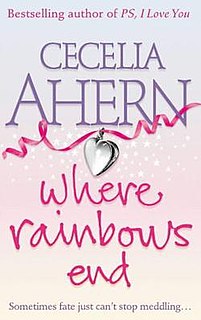 W
WWhere Rainbows End is the second novel by Irish writer Cecelia Ahern, published in 2004. The entire novel is written in epistolary structure in the form of letters, emails, instant messages, and newspaper articles. The book reached number one in Ireland and UK and was a best seller internationally. The book won the German Corine Award in 2005. In 2014, the novel was adapted into a film titled Love, Rosie.